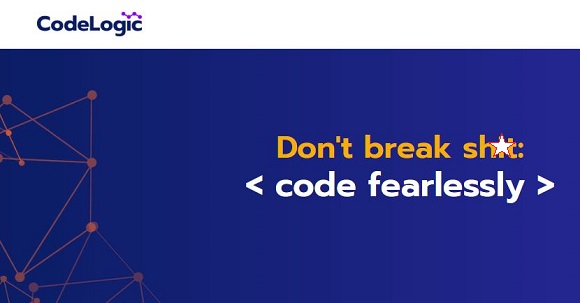Beyond build breakers: CodeLogic's binary scanning & runtime analysis combo
Software application development teams need depth of insight into increasingly complex software to stop breaking applications and code fearlessly.
Fearlessly… really?
Yes, this is the twist (dare we say spin?) now being delivered by CodeLogic, a firm that describes itself as a Continuous Software Intelligence (CSI) company.
Its new developer toolkit scans post-compile binaries, runtime app behaviour and database connections to provide an up-to-the-second picture of infrastructure-wide software connections and dependencies.
CodeLogic says it addresses the ‘unrelenting complexity’ that, according to Stack Overflow, results in the #1 cause of developer unhappiness: lack of productivity.
It frees developers from managing break/fix cycles, training new team members, chasing down vulnerabilities for security audits, evaluating technical debt, and other non-coding activities.
Breaking the build breakers
Every day, software developers make code changes knowing there is a high probability that the code changes they push and commit will break something.
Not just the build but break the application further downstream.
This pervasive problem slows dev teams, impairs productivity and, ultimately, makes innovation more difficult. Traditional Software Intelligence (SI) and application scanning tools rely on the static scanning of source code and fail to address this issue.
“Enterprise-scale software systems are unwieldy in complexity and often defy human understanding. As a result, developers are increasingly frustrated and unproductive. The solution [to developer frustration] is to allow developers to see in advance the impacts that code changes will produce and to ameliorate those changes without breaking code. The CodeLogic CSI platform provides exactly that – total and up-to-date visibility across the entire software and database structure,” said Brian Pierce, CEO of CodeLogic.
The CodeLogic CSI platform makes sense of the complex and helps developers end break/fix cycles.
It exposes all software connections and interdependencies – from code to methods to APIs to databases – by performing post-compile scans of binary code and scanning runtime environments. With CodeLogic, development teams have unparalleled visibility into software structures not present in the source code itself, including inserted third-party libraries, stored procedure calls, and database connections.
“Combining binary scanning and runtime analysis defines a major evolution of developer-focused technologies that can dig deeply, widely and continuously into the true structure of software. We scan the code and all connected data sources,” Pierce said.
He claims that no other solution can store and reference the relationships and dependencies between various software elements and traverse different languages, frameworks, data models and underlying infrastructures.
Key functions
- By capturing all code and data dependencies in a searchable graph database, CodeLogic empowers developers to write code with the ability to see other parts of the system that are connected and analyse what is likely to break.
- CodeLogic CSI helps developers visualise highly complex and interconnected software applications that have become increasingly fragile, too big to comprehend fully and impossible to document accurately. An automated ‘impact score’ for methods, classes, and overall application health ensure that complexity becomes manageable.
- With CodeLogic, teams can anticipate and scope planned projects by fully understanding downstream impacts to reconsider proposed plans and roadmaps before investing weeks of effort.
- With increasing security threats, organisations must now maintain accurate maps of REST endpoints and be prepared to respond to zero-day events instantly. CodeLogic CSI allows these activities to be automatically performed in minutes, rather than days or weeks.
Both internal stakeholders and external service providers can collaborate and maintain scalable applications using CodeLogic CSI, which provides continuous scanning and a single-source-of-truth that serves as ‘living documentation’ to keep dev teams on the same page.

CodeLogic: Not afraid of telling it like it is.



